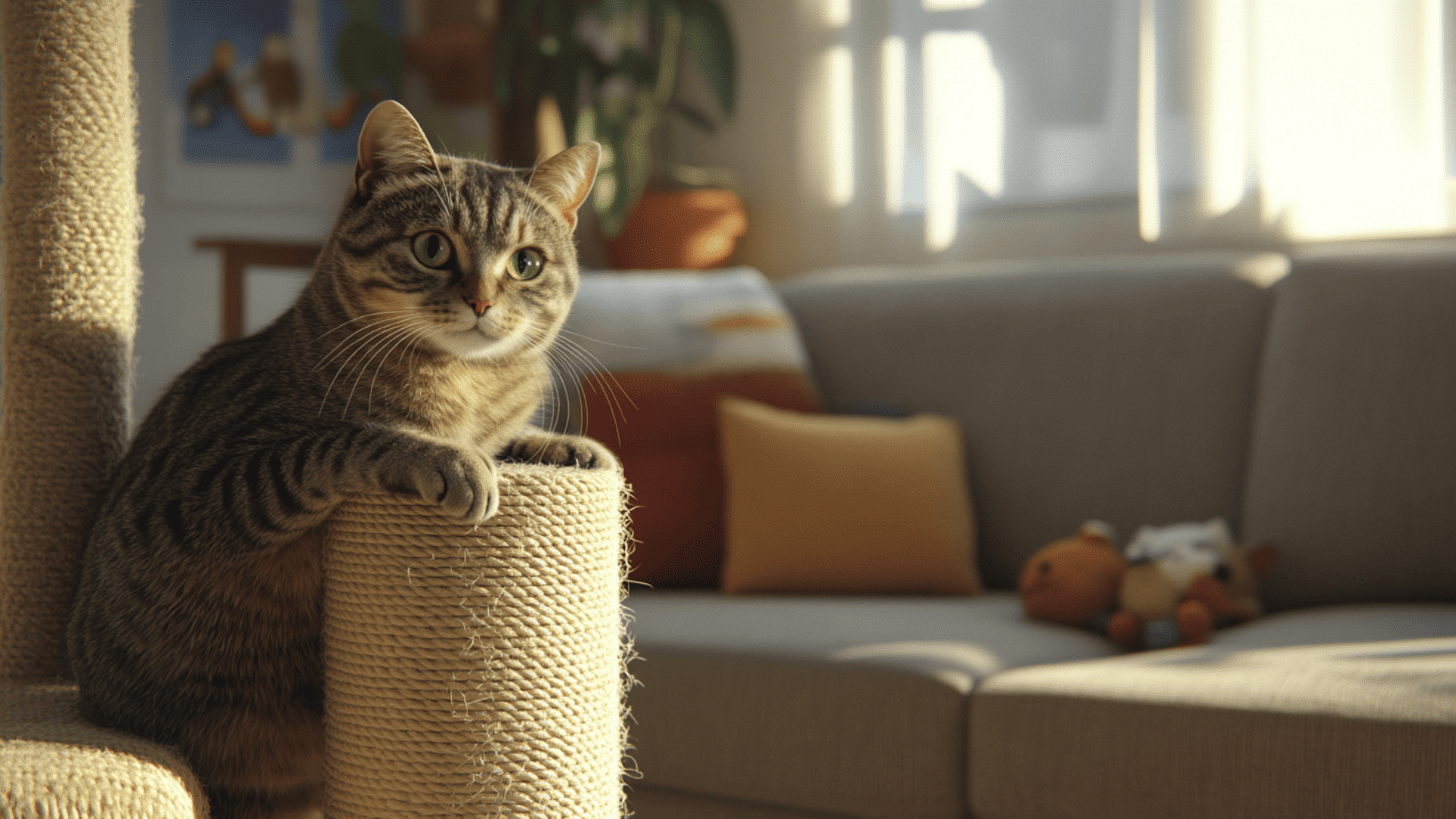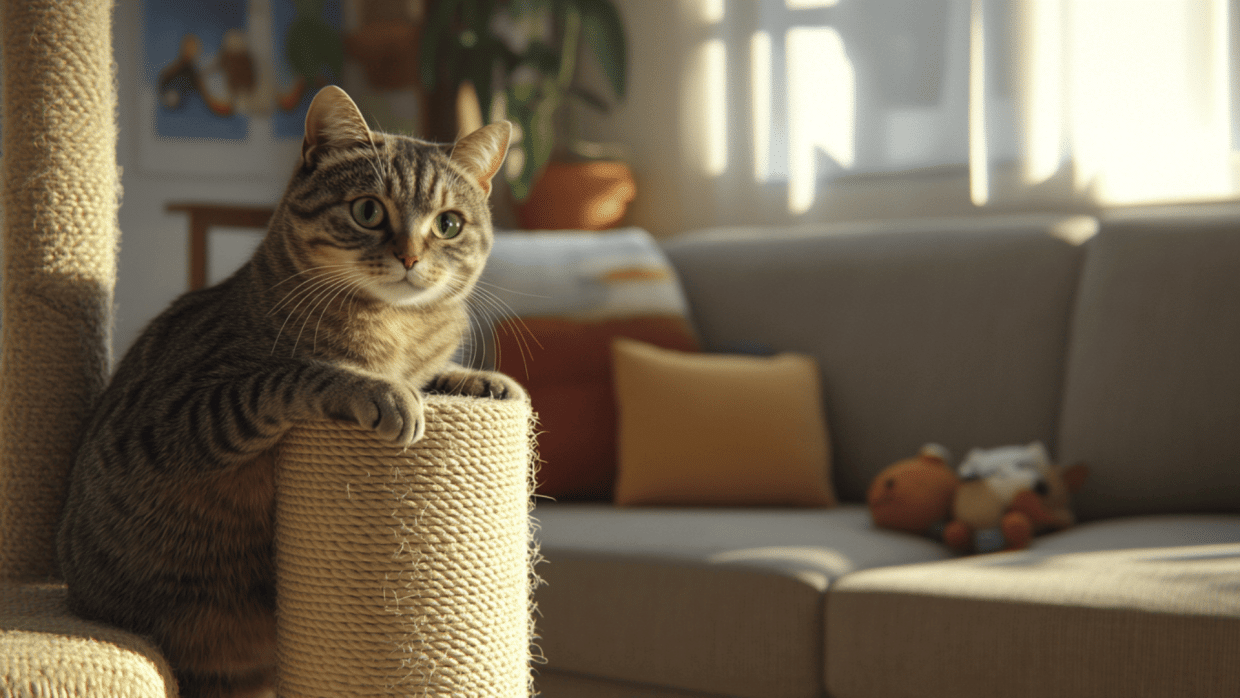
- arrow_back Home
- keyboard_arrow_right Cat Care & Grooming
Alternatives to Declawing a Cat You Can’t Miss

Cat Care & Grooming Joanna Tate April 25, 2025
Thinking about declawing your cat to stop the scratching? You’re not alone, but it might not be the kindest option.
Many cat owners wonder if there’s a better way to protect their furniture without hurting their furry friend. The good news? There are safe, simple alternatives to declawing that actually work.
In this blog, we’ll go over what declawing really means, why it’s risky, and the best options you can try instead, from nail caps to training tips.
You’ll leave with clear ideas that help you keep your cat happy and your home scratch-free.
Curious which method could work best for your cat? Let’s take a look.
Why Declawing isn’t the Answer
Declawing might seem like a quick fix for scratching, but it’s much more than a simple nail trim. It’s a serious procedure that removes part of your cat’s toes along with the claws.
What Declawing Really is?
Declawing is a surgical operation where the last bone of each toe is removed. This is the part that holds the claw. It’s not just clipping the nails; it’s like cutting off a human finger at the last joint. It changes how your cat walks and uses its paws.
Why is it a Problem?
Declawing can cause long-term pain or nerve damage. Some cats have trouble walking or balancing after the surgery.
It can also lead to behavior problems. Cats may become more stressed or aggressive, and some even stop using the litter box because their paws hurt.
It also takes away a cat’s main way of defending itself. Scratching is natural for cats, not just for marking territory, but also for stretching and relieving stress.
Where is it Banned?
Many places now ban or discourage declawing. Several cities and states in the U.S. have made it illegal. Countries like the U.K., Australia, and Germany have banned it too. Even the American Veterinary Medical Association advises against it.
Declawing isn’t just outdated, but it’s also widely seen as inhumane and unnecessary.
The 7 Best Alternatives to Declawing a Cat
There are many ways to stop unwanted scratching without putting your cat through surgery. These options are safer, more humane, and often more effective in the long run.
1. Scratching Posts and Pads
Cats need to scratch—it’s how they stretch, mark territory, and keep their claws healthy. Giving them a good scratching surface is one of the easiest ways to stop them from using your couch.
Some cats like vertical scratchers; they can reach up and stretch on. Others prefer horizontal pads they can dig into on the floor. Try both types to see what your cat likes best.
Materials matter, too. Most cats enjoy sisal rope, cardboard, or carpet. Place scratchers near your cat’s favorite hangout spots or in areas where they’ve scratched before.
If you’re on a budget, you can make your own. A cardboard box, a piece of wood wrapped in rope, or even an old rug can work well.
2. Regular Nail Trimming
Keeping your cat’s claws trimmed makes them less sharp and reduces the chance of damage to your furniture or skin.
Most cats need their nails trimmed every 2 to 4 weeks. Kittens may need it more often since their nails grow fast.
You’ll need a pair of pet nail clippers or a human nail cutter with a clean, sharp edge. A towel can help hold your cat still. Some people use treats or have a friend help.
Start by gently pressing the paw to extend the claw. Trim just the tip—avoid the pink area (the quick), as it can bleed.
If you’re unsure, there are many short videos online that show how to do it step-by-step. It might take practice, but most cats get used to it.
3. Nail Caps
Nail caps are small, soft covers that fit over your cat’s claws. They stop damage while letting your cat keep its natural scratching motions.
To apply them, trim your cat’s nails first. Then fill each cap with a bit of glue (included in the kit) and gently press it onto the claw.
It only takes a few minutes, and many cats don’t mind them once they’re on. You can also find helpful videos that show the full process.
One benefit of nail caps is that they’re non-surgical and painless. But some cats may try to pull them off at first. They also need to be replaced every 4 to 6 weeks as the claws grow.
Nail caps aren’t expensive. A pack usually costs under $15 and lasts for several applications. They come in fun colors and sizes for kittens and adults. Just be sure to check your cat’s paws regularly to keep them comfortable.
4. Positive Reinforcement Training
You can teach your cat to scratch where you want using rewards. This method helps shape good behavior without punishment.
Clicker training is a simple way to do this. You click a small device the moment your cat does something right, like using a scratching post, then give a treat right after. The sound helps your cat connect the action to the reward.
Over time, your cat learns that scratching approved surfaces gets them something good. Praise and treats work wonders, especially when used consistently. Stay patient, and keep sessions short and fun.
5. Environmental Enrichment
A bored cat is more likely to scratch out of frustration or stress. Giving your cat plenty to do can reduce bad habits and keep them happy.
Toys that mimic prey, like feather wands or balls, are great for active play. Cat trees offer space to climb and perch, while puzzle feeders turn mealtime into a fun challenge.
Cats love variety. Rotate toys often and create spots to hide, jump, and explore. A rich environment gives your cat better outlets for energy and cuts down on unwanted scratching.
Scratching isn’t the only behavior cats use to manage stress. Cats grooming themselves is another common habit that helps them stay calm and clean.
6. Pheromone Sprays and Diffusers
Synthetic pheromones can help calm your cat and lower stress, which may reduce scratching.
Products like Feliway copy the natural scent cats leave when they feel safe. These sprays or plug-in diffusers send out a calming signal that humans can’t smell.
Use them near scratching spots, in new environments, or during stressful changes like moving. They’re especially helpful for anxious or high-strung cats.
7. Deterrents
If your cat keeps going back to the same off-limits spot, deterrents can help break the habit.
Sticky materials like double-sided tape or products like Sticky Paws make surfaces less pleasant to scratch. Aluminum foil and citrus-scented sprays also work well since many cats dislike those textures and smells.
Place deterrents on furniture edges, door frames, or wherever your cat likes to scratch. At the same time, give them a nearby scratcher to redirect the behavior.
Over time, your cat will learn which spots are okay and which ones to leave alone.
What About Surgical Alternatives?

Some people ask if there’s a less harmful surgery than declawing. One option you might hear about is called a Deep Digital Flexor Tendonectomy (DDFT), but it’s not as harmless as it sounds.
What is a Tendonectomy?
In a tendonectomy, the vet cuts the tendon that controls the claw’s movement. This means the cat can no longer extend its claws to scratch, but the claws are still there.
The nails keep growing, so they need to be trimmed often, usually more than usual.
It’s less painful than declawing at first, but it still limits your cat’s natural movement and can lead to long-term problems like stiff joints or overgrown claws if not maintained.
How does it Compare to Declawing?
Unlike declawing, a tendonectomy doesn’t remove bones or claws. That makes it seem like a kinder choice. But it still changes how your cat moves and behaves. It doesn’t solve the root issue—it just hides it.
In both surgeries, your cat loses full use of its claws. And both come with health risks, recovery time, and lifelong impact.
What Vets Say
The American Veterinary Medical Association (AVMA) does not recommend tendonectomies. Like declawing, it’s only seen as a last resort when all other methods fail, and even then, many vets won’t perform it.
Read AVMA’s policy: Declawing of domestic cats
Other AVMA resources: Alternatives to declawing
Most experts agree that it’s better to manage scratching with safe, non-surgical options. These protect both your cat and your home without putting your pet’s health at risk.
Choosing the Right Option for Your Cat
Not every alternative works the same for every cat. To find the best solution, it helps to think about your cat’s age, breed, and behavior. If you have more than one cat, their group dynamic matters too.
Age, Breed, and Personality Considerations
Every cat is different, so it’s important to match the right method to your cat’s age, breed, and behavior. Here’s a quick breakdown to help you choose what might work best.
- Kittens: Easier to train and quick to adjust to nail trimming or caps. Great time to build healthy habits.
- Seniors: May need more patience, but can still adapt with gentle handling and routine.
- Active Breeds: Cats like Bengals and Abyssinians need more play and stimulation to reduce boredom scratching.
- Calm Breeds: Laid-back cats may do better with training and soft interventions.
- Shy Cats: Sensitive to change, so calming tools like pheromone sprays work better than sudden fixes.
- Bold Cats: More open to trying new tools, like nail caps or scratcher types.
Choosing the right approach depends on your cat’s needs. Once you understand their style, it becomes easier to keep both them and your furniture happy.
Multi-Cat Household Tips
In homes with more than one cat, scratching can sometimes be a way to mark territory. Make sure each cat has its own scratching post or area. This helps prevent fights and keeps the peace.
Try placing scratchers in shared and private spaces. Keep an eye on which cat uses what, and adjust based on their preferences.
Also, be fair with rewards and training. All cats should feel included and safe. When done right, even a multi-cat household can stay calm and scratch-free.
Expert Advice: What Veterinarians Recommend
Veterinarians and feline behaviorists across the U.S. agree: declawing is unnecessary and often harmful. Instead, they recommend humane, effective alternatives that support your cat’s natural behaviors while protecting your home.
What the Experts Say
Dr. Mark, a practicing veterinarian, cautions that declawing can lead to chronic pain, behavioral issues, and litter box problems.He emphasizes that more than half of declawed cats may develop litter box avoidance, leading to further complications.
Read Article:Why Declawing Your Cat Is Inhumane and Dangerous, According to a Vet
Stephen Quandt, a certified feline behaviorist, states, “It’s not a necessary surgery and in that sense is unnatural for the cat and robs them of a major defense system and the ability to scratch themselves with their front paws if they’re itching.”
Read Article:6 Expert-Approved Alternatives to Declawing a Cat
The American Veterinary Medical Association (AVMA) advises that declawing should only be considered after all other alternatives have been tried and failed.They recommend providing appropriate scratching surfaces and using positive reinforcement to manage scratching behavior.
Read Article:Six Alternatives to Declawing Your Cat
Behaviorist Insights
Certified behaviorists highlight that scratching is a natural and essential behavior for cats.It allows them to mark territory, stretch muscles, and relieve stress.Suppressing this behavior through declawing can lead to increased anxiety and aggression.
They recommend environmental enrichment, such as providing various scratching posts, engaging toys, and interactive play sessions, to redirect scratching behavior positively.Training techniques, like clicker training and rewarding appropriate scratching, can also be effective.
The Bottom Line
Leading veterinary and behavioral experts agree: declawing is an outdated practice with significant risks.By understanding your cat’s needs and providing suitable alternatives, you can maintain a harmonious household without resorting to invasive procedures.
For more detailed guidance, consult resources from the American Veterinary Medical Association and the American Association of Feline Practitioners.
You can access the full AAFP Declawing Position Statement here: AAFP Declawing Position Statement
Additionally, the AAFP has developed a Claw-Friendly Educational Toolkit to help veterinary professionals and cat caregivers understand and implement alternatives to declawing.This resource includes educational materials, practice implementation plans, and client brochures.
Explore the toolkit here: AAFP Claw Friendly Educational Toolkit
Conclusion
There are many kinds, safe alternatives to declawing a cat that can protect your furniture and keep your cat happy. From nail trimming and scratcher training to using caps and sprays, these methods work without causing harm.
Try out a few options and see what fits your cat’s needs and personality. A little patience goes a long way, and your effort can lead to a healthier, more relaxed home for both of you.
Remember, scratching is natural for cats, and with the right tools, you can guide that behavior in the right direction.
Want to learn more about caring for your cat? Check out our other blogs for helpful tips, tricks, and advice for happy, healthy pets.


Dedicated to cat health, behavior, nutrition, and happy pet parenting.
Copyright © 2025 Archiecat.com




Be the first to leave a comment